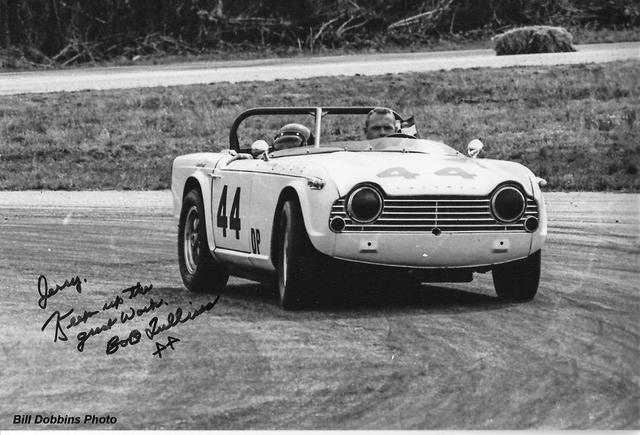

| 1955 Triumph TR2 (1955 Le Mans): Hoping to capitalize on the previous years results of a private TR2, Standard-Triumph entered a full team of three factory supported cars at Le Mans in 1955. All three had stock TR2 2.0L 4-cylinder engines, but the factory had added upgraded front disc brakes and increased the size of the carburetors to give it slightly more horsepower, combined with a high-port cylinder head. Model by SPARK 1/43 |
1955 Triumph TR2 (1955 Le Mans): Le Mans was the test bed for the improvements which would be introduced on the new TR3 model in the fall. This car driven by Ninian Sanderson and Bob Dickson finished 14th overall and 5th in class behind the Bristol 405's and the Frazer Nash Sebring. Sanderson would win Le Mans in 1956 driving the Ecurie Ecosse Jaguar and finish 2nd in 1957, again driving a Ecosse Jaguar. Model by SPARK 1/43 |
1955 Triumph TR2 (1955 Le Mans): Ken Richardson and Bert Hadley drove a flawless race at Le Mans in 1955, finishing in 15th position overall behind their Standard-Triumph teammates. The work's TR2's had been very successful in European rallying, along with the Mille Miglia and Ulster TT. Standard acquired Triumph in 1945, but didn't unveil a car bearing the Triumph name until the London Motor Show in 1953. Production of the TR2 began the following year, terminating in autumn 1955. Model by SPARK 1/43 |
1955 Triumph TR2 (1955 Le Mans): Triumph proved the TR2's ability on the Belgian Jabbeke Highway, where a streamlined version achieved 124 mph. In 1955 Le Mans trim, the TR2 could hit 120 mph on the Mulsanne Straight. The success in Belgium and at Le Mans helped Triumph sell engines to smaller manufacturers like Morgan, Peerless, Swallow and Doretti. Model by SPARK 1/43 |
| 1955 Triumph TR2 (1955 Le Mans): Seventy cars competed for the sixty grid positions at Le Mans in 1955. Originally consigned to be a reserve car, this Triumph works entry was elevated to race status when not all sixty cars arrived at Le Mans. Driven by Leslie Brooke and Mort Morris-Goodall, the car eventually finished in 19th position, but was not classified because it had failed to cover the minimum required distance in the race. Model by SPARK 1/43 |
1955 Triumph TR2 (1955 Le Mans): Leslie Brooke spent a couple of hours digging the car out of the sand trap at Tetra Rouge a delay that cost them 29 laps. Triumph built four Le Mans specification cars. In addition to the three cars at Le Mans, Triumph also built a fourth Le Mans specification car which was the test mule for the team; but was not brought to France. Model by SPARK 1/43 |
1955 Triumph Factory Team at Le Mans |
1955 Triumph Factory Team at Le Mans |